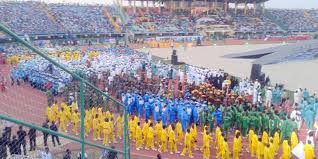Column
The Minister’s Scathing Remark On WAEC …Two Conflicting WASSCE Results Released
The West African Examinations Council (WAEC) recently released the results of the last May/June West African Senior School Certificate Examinations (WASSCE), showing a poor outing of candidates from Nigeria who participated in the examinations. As announced by Dr Iyi Uwadiae, Head, WAEC National Office, out of 1,540,250 candidates who wrote the examinations, only 472,906 candidates made the desired results.
But to the chagrin of many, the WAEC authorities last week, released yet another result of the same candidates who participated in the examinations, conflicting with the results released earlier. According to reports, some candidates who made good grades in the first results that were released, failed in the results released last week by the WAEC authorities.
As indicated by WAEC’s Head of National Office, the last May/June result shows a mass failure of candidates as only 31% of the candidates could make five credits, including English and Mathematics. In the reports, WAEC lamented the abysmal failure of Nigerian candidates in the past four years.
Apparently angered by the two conflicting WASSCE results released by WAEC, the Minister of State for Education, Nyesom Wike, last week, summoned the WAEC officials to his office to explain what led to the two conflicting results released by the WAEC authorities,
Addressing the WAEC officials in Abuja, led by Dr Uwadiae, Head of its National Office, the Minister of State for Education took a swipe at the WAEC authorities, and warned that the Federal Government would not accept such conflicting WASSCE results. Wike noted that such conflicting results could affect the future of Nigerian youth (students), and therefore asked the WAEC authorities to take a second look at the last May/June WASSCE, and publish an authentic result. He, also advised WAEC to address the issue of cancellation and withholding of results of thousands of candidates.
Responding on behalf of WAEC, Dr Uwadiae, Head of its National Office, said the conflicting WASSCE results, was as a result of what he termed “human error”. He therefore, assured that everything humanly possible would be done to correct the anomaly.
That said, it is sad and unfortunate that WAEC could make such avoidable mistake in the release of WASSCE results, a situation that may (if not properly handled) ruin the future of thousands of candidates in the last WASSC examinations.
Again, it may not be out of place to suggest that the mass failure in WASSCE in Nigeria in the past four years, especially in the last May/June examinations, is as a result of “human error” on the part of WAEC officials.
One can recall vividly that in 2007, shortly before leaving office as president of this country, Chief Olusegun Obasanjo chided the WAEC authorities over the incessant cancellation of the results of its examinations, conducted in the country. Giving an insight into the mass failure in WASSC examinations, Obasanjo lamented that between 2000-2004, only about 33.3% of candidates at the Senior School Certificate Examinations passed not less than five subjects, including English and Mathematics at the minimum of Credit level. He therefore, asked the WAEC authorities to nip the mind-boggling situation in the bud.
But while the WAEC authorities are being blamed for the mass failure in WASSC examinations in Nigeria, the various levels of government in the country should also be held responsible for the unfortunate situation. It is common knowledge that secondary education belongs to the critical level and sector of any economy. This is why most developed economies spend the highest chunk of their budget on secondary education.
Regrettably in Nigeria, the authorities at the federal, state and local government levels do not seem to have paid the desired attention to secondary education. In some states, secondary schools are dotted with dilapidated school buildings.
Worse still, the teachers, saddled with the responsibility of impacting knowledge to school children are not given adequate incentives and their salaries not paid as at when due. As a result, the teachers sometimes abandon the classrooms for their own businesses in order to make ends meet. How then would there not be mass failure in examinations conducted by WAEC.
What’s more, the nation’s school management and supervision which are palpably low, attracts less attention from some ministers, commissioners, top civil servants and politicians. Education, they say, is the foundation of other sectors of the economy, and any government, be it at the federal, state or local levels that brushes education aside, does so at its own risk.
Although former President Obasanjo made particular reference to the period between 2000-2004 in the mass failure in WAEC examinations, there is everything to show that the mass failure will continue in the examinations conducted by WAEC in Nigeria.
According to education analysts, there may be no significant improvement in the WASSC examinations since secondary education has not been given the attention it deserves. It is instructive to state that the failure by the authorities to bridge the process at the secondary level tends to create difficulties in upgrading the standard at even the primary level, in both quantitative and qualitative terms.
Therefore, all hands must be on deck now to shore up post-primary education in the country in order to pull Nigeria from the quagmire of poor performance in examinations conducted by WAEC.
All said, it is hoped that WAEC will live up to its responsibility and publish a result that would be acceptable to both the government and the candidates. It’s also instructive to state that WAEC decisions have for too long, ruined the future of many of its candidates through withholding of exam results, as well as outright cancellation of thousands of results of unsuspecting candidates.
Column
Renewable Energy Faces Looming Workforce Crisis

Column
Why Oil Prices Could See Significant Upside Shift

Column
Nuclear Stocks Soar on Stargate AI Infrastructure Announcement
-

 Business3 days ago
Business3 days agoPETAN, Others Unveil ALCO, Get NCDMB’s Support … Mull Synergy With APPO, AU
-

 Sports3 days ago
Sports3 days agoNYG:154 Nasarawa Contingent Storms Kwara For Zonal Eliminations
-

 Business3 days ago
Business3 days agoAON Lifts Ban On Freed Ibom Air Passenger
-

 Sports3 days ago
Sports3 days agoNigeria delegation Visits London over 2030 Commonwealth bid
-

 News3 days ago
News3 days agoNigeria’s Debt To W’Bank IDA Hits $19.2bn -Report
-

 Sports3 days ago
Sports3 days agoD’Tigers flawless finish against Lions in AfroBasket
-

 News3 days ago
News3 days agoChurch Renders Free Medical Outreach, Others To Host Communities
-

 Maritime3 days ago
Maritime3 days agoNCC Announces Telecoms Facilities Protection Measures

